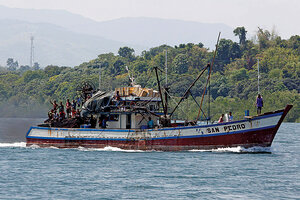Southeast Asia eyes Chinese air zone expansion
China has suggested it will create more air defense zones, which worries Southeast Asian nations that have territorial disputes with China.

Filipino fishermen waved from a boat bound for the Scarborough Shoal in May. China now bars access.
Erik De Castro/Reuters
BeiJing
Nowhere are governments keeping a closer eye on China's latest move to press its territorial claims (see related article) than in Southeast Asia. And nowhere are they more concerned.
"China keeps upping the ante," says Itty Abraham, who teaches international relations at the National University of Singapore. "All the countries in Southeast Asia are worried."
At the moment, China is focused on its claim to the group of East China Sea islands known here as the Diaoyu and in Japan, which controls them, as the Senkaku.
But on the back burner sit other Chinese territorial claims to huge swaths of the South China Sea, and to islands and reefs that dot that ocean to which Vietnam, the Philippines, Malaysia, and Brunei also lay claim.
And amid fears that Beijing's declaration of an "air defense identification zone" in the East China Sea is a new way to assert Chinese ambitions there, recent statements by officials in Beijing about future plans sound ominous to Southeast Asian ears.
"At the right time, when preparations are ready," China will announce other ADIZs, Foreign Ministry spokesman Qin Gang said Nov. 27.
There is only one place they could put them: the South China Sea. And it seems almost certain that one or more of them would overlap with Vietnam's existing ADIZ, and fall over the disputed Paracel Islands.
The Philippines also has reason to worry; its ships are currently barred from entering the Scarborough Shoal, 130 miles off its coast, by Chinese vessels stationed there. Philippines Foreign Ministry spokesman Raul Hernandez rejected China's ADIZ as an infringement of freedoms in international airspace, saying it "transforms the entire air zone" into "China's domestic airspace."
Washington is asking China not to set up any ADIZ in the South China Sea without consulting the other countries in the area, according to a senior US official traveling with Vice President Joe Biden on his current East Asia tour, Japan's Kyodo news agency reported.
Beijing indulged in no such consultations with its East China Sea neighbors – Japan, South Korea, and Taiwan – before declaring its new zone, which overlaps with all three of their existing ADIZs.
China, however, recently has been making efforts to allay Southeast Asian nations' suspicions. Chinese President Xi Jinping launched a diplomatic offensive at last October's Asia-Pacific Economic Cooperation summit in Indonesia, and Prime Minister Li Keqiang followed that up with a tour of the members of the Association of Southeast Asian Nations.
At a recent top-level meeting to set China's diplomatic strategy toward Southeast Asia, President Xi told colleagues that his government should do more things "to warm the hearts of others, so that neighboring countries will become even friendlier."
"It is very possible that China will establish another ADIZ in the South China Sea because the same conditions apply there as in the East China Sea – China is rising and we face territorial disputes," says Ni Lexiong, an analyst with the military-affiliated Shanghai National Defense Strategy Research Institute.
"But it won't happen very soon," he adds, "because our neighbors could see it as a hostile act."

